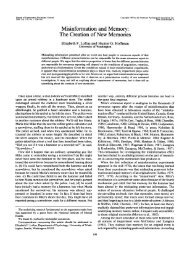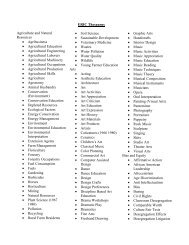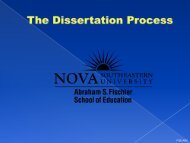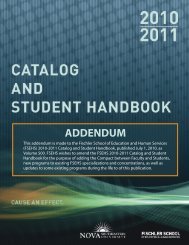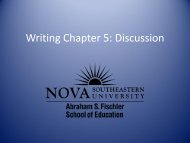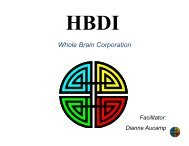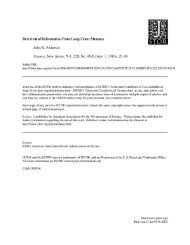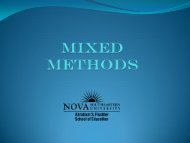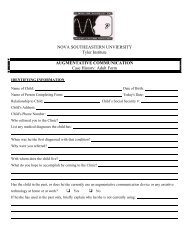Quantitative Research Methods - Fischler School - 1
Quantitative Research Methods - Fischler School - 1
Quantitative Research Methods - Fischler School - 1
Create successful ePaper yourself
Turn your PDF publications into a flip-book with our unique Google optimized e-Paper software.
<strong>Quantitative</strong> <strong>Research</strong> <strong>Methods</strong><br />
FSEHS-ARC
Overview<br />
• <strong>Research</strong> Process<br />
• <strong>Quantitative</strong> <strong>Methods</strong><br />
• Designs<br />
• Validity and <strong>Research</strong> Designs
A Definition of <strong>Research</strong><br />
<strong>Research</strong> is a process of steps used to<br />
collect and analyze information in order to<br />
increase our understanding of a topic or<br />
issue.
Problems With <strong>Research</strong> Today<br />
• Contradictory or vague findings<br />
• Questionable data<br />
• Unclear statements about the intent of<br />
the study<br />
• Lack of full disclosure of the datacollection<br />
procedure<br />
• Inarticulate rendering of the research<br />
problem
The Process of <strong>Research</strong><br />
Identify the<br />
<strong>Research</strong> Problem<br />
Report<br />
and<br />
Evaluate <strong>Research</strong><br />
Review the<br />
Literature<br />
Analyze and<br />
Interpret<br />
Data<br />
Collect Data<br />
Specify a<br />
<strong>Research</strong><br />
Purpose
The Process of <strong>Research</strong>:<br />
Identify the <strong>Research</strong> Problem<br />
• Specify a problem<br />
• Justify a problem<br />
• Suggest a need to study the problem for<br />
audiences
The Process of <strong>Research</strong>:<br />
Review the Literature<br />
• Locate resources<br />
– Books<br />
– Journals<br />
– Electronic resources<br />
• Select resources<br />
– Determine the relevant resources for the<br />
topic<br />
– Organize the resources by developing a<br />
“Literature Map”<br />
• Summarize the resources in a literature<br />
review
The Process of <strong>Research</strong>:<br />
Specify a <strong>Research</strong> Purpose<br />
• Identify the purpose statement<br />
– The major intent of the study<br />
– The participants in the study<br />
– The site of the study<br />
• Narrow the purpose statement<br />
– <strong>Quantitative</strong>: Write research<br />
questions and/or hypothesis<br />
– Qualitative: Identify a central<br />
phenomenon and write<br />
subquestions
The <strong>Research</strong> Process:<br />
Collect Data<br />
• Determine the data-collection method<br />
• Select the individuals to study<br />
• Design or select data-collection<br />
instruments and outline data-collection<br />
procedures<br />
• Obtain permissions<br />
• Gather data
The <strong>Research</strong> Process:<br />
Analyze and Interpret Data<br />
• Take the data apart to look at individual<br />
responses<br />
• Represent the data in tables, figures, and<br />
pictures<br />
• Explain conclusions from the data that<br />
address the research questions
Ethical Considerations in <strong>Research</strong><br />
• Respect the rights of the participants<br />
• Honor the requests and restrictions of the<br />
research site<br />
• Report the research fully and honestly
Definitions of <strong>Quantitative</strong> and<br />
Qualitative <strong>Research</strong><br />
<strong>Quantitative</strong> <strong>Research</strong><br />
A type of educational research in which the researcher<br />
decides what to study; asks specific, narrow questions;<br />
collects quantifiable data from participants; analyzes these<br />
numbers using statistics; and conducts the inquiry in an<br />
unbiased, objective manner.
Characteristics of <strong>Quantitative</strong><br />
<strong>Research</strong><br />
• An emphasis on collecting and analyzing<br />
information in the form of numbers<br />
• An emphasis on collecting scores that<br />
measure distinct attributes of individuals<br />
and organizations<br />
• An emphasis on the procedures of<br />
comparing groups or relating factors about<br />
individuals or groups in experiments,<br />
correlational studies, and surveys
Characteristics of <strong>Quantitative</strong> <strong>Methods</strong><br />
in the Process of <strong>Research</strong><br />
<strong>Quantitative</strong><br />
Characteristics<br />
Steps in the <strong>Research</strong><br />
Process<br />
•Descriptive/Explanatory<br />
•Major Role<br />
•Justify Problem<br />
•Specific and Narrow<br />
•Measurable/Observable<br />
•Predetermined<br />
Instruments<br />
•Numeric Data<br />
•Large Numbers<br />
•Statistical<br />
•Description of Trends<br />
•Comparisons/Predictions<br />
•Standard and Fixed<br />
•Objective and Unbiased<br />
Identify a Problem<br />
Review the Literature<br />
Specify a Purpose<br />
Collect Data<br />
Analyze and Interpret Data<br />
Report and Evaluate
<strong>Quantitative</strong> <strong>Methods</strong><br />
Intervention<br />
<strong>Research</strong><br />
Nonintervention<br />
<strong>Research</strong><br />
Explaining whether an<br />
intervention influences<br />
an outcome for one<br />
group as opposed to<br />
another group<br />
Associating or<br />
relating variables<br />
in a predictable<br />
pattern for one<br />
group of<br />
individuals<br />
Describing trends for<br />
the population of<br />
people<br />
Experimental <strong>Research</strong>:<br />
Between-Subjects<br />
Approach<br />
Nonexperimental<br />
<strong>Research</strong>:<br />
Correlational Approach<br />
Nonexperimental<br />
<strong>Research</strong>:<br />
Survey Approach
Method, <strong>Research</strong>, Approach and Design<br />
(Edmonds & Kennedy, 2012)<br />
Level<br />
METHOD 1<br />
▼<br />
RESEARCH 2<br />
▼<br />
APPROACH 3<br />
▼<br />
DESIGN 4<br />
Explanation<br />
The method is the theoretical, philosophical, and data analytic perspective. The method<br />
can be quantitative, qualitative, or mixed (e.g., a quantitative method 1 ).<br />
▼<br />
<strong>Research</strong> refers to the systematic process of group assignment, selection, and data<br />
collection techniques. <strong>Research</strong> can be experimental, quasi-experimental, or nonexperimental<br />
(e.g., a quantitative method 1 and experimental research 2 ).<br />
▼<br />
The approach is the first step to creating structure to the design, and it details (a) a<br />
theoretical model of how the data will be collected, and (b) if one case, one group, or<br />
multiple groups will be associated with the process (e.g., a quantitative method 1 ,<br />
experimental research 2 with a between-subjects approach 3 ).<br />
▼<br />
The design is the actual structure or framework that indicates (a) the time frame(s) in<br />
which data will be collected or how and when the data will be analyzed using qualitative<br />
methods, (b) when the treatment will be implemented (or not), and (c) the exact number<br />
of groups that will be involved (e.g., a quantitative method 1 , experimental research 2 with a<br />
between-subjects approach 3 and a pre- and posttest control group design 4 ).<br />
Edmonds, W. A., & Kennedy, T. D. (2012). An applied reference guide to research designs: <strong>Quantitative</strong>, qualitative, and mixed<br />
methods. Thousand Oaks, CA: Sage.
Experimental research utilizing a betweensubjects<br />
approach with a pre- and posttest<br />
control group design<br />
<strong>Research</strong> Question: Does active parent engagement in selecting and<br />
using routine-based activities have a positive effect on children's language<br />
and appropriate behavior development?<br />
Assignment Group Pretest Treatment Posttest<br />
R 1 (n = 22) TELD-3, ECBI<br />
Family-Centered<br />
Intervention<br />
TELD-3, ECBI<br />
R 2 (n = 19) TELD-3, ECBI - TELD-3, ECBI<br />
Time ►<br />
Chao, P., Bryan, T., Burstein, K., & Ergul, C. (2006). Family-centered intervention for young<br />
children at-risk for language and behavior problems. Early Childhood Education Journal,<br />
34(2), 147-153.
Nonexperimental research utilizing a<br />
correlational approach with an explanatory design<br />
<strong>Research</strong> Question: What classroom motivation<br />
variables are related to students’ sense of<br />
belonging?<br />
Variables Students (n = 249)<br />
Motivation<br />
Self, efficacy, instrumentality,<br />
goals<br />
Sense of belonging<br />
Sense of belonging survey<br />
Walker, C. O., & Greene, B. A. (2009). The relations between students’ motivational beliefs<br />
and cognitive engagement in high school. Journal of Educational <strong>Research</strong>, 102(6) 463-471.
Nonexperimental research utilizing a survey<br />
approach with a cross-sectional design<br />
<strong>Research</strong> Question: What evidence exists to<br />
demonstrate the prevalence and consequences of<br />
recurrent low-back pain in children?<br />
Variable (N = 500) Time point 1<br />
Low-back pain<br />
Low-back pain<br />
survey<br />
Jones, M. A., Stratten, G., Reilly, T., & Unnithan, V. B. (2004). A school-based survey of<br />
recurrent non-specific low-back pain prevalence and consequences in children. Health<br />
Education <strong>Research</strong>, 19(3), 284-289.
Threats to Internal Validity (examples)<br />
Threat<br />
History<br />
Maturation<br />
Testing<br />
Instrumentation<br />
Explanation<br />
Any event that occurs during the time of the treatment<br />
and the posttest that could affect the outcome (e.g.,<br />
natural life events such as a death in the family, change in<br />
job, or moving).<br />
The natural process of changing, growing, and learning<br />
over time.<br />
The effects of practice familiarity in taking the same test<br />
more than once (e.g., the participant who takes the same<br />
math achievement test twice in the pre- and posttest<br />
measures may improve performance simply because of the<br />
familiarity with the test)<br />
The change in a measuring instrument over time (i.e.,<br />
some instruments undergo revisions).<br />
Edmonds, W. A., & Kennedy, T. D. (2010). A reference guide to basic research design for education and the social and behavioral<br />
sciences. New York, NY: Pearson.
Threats to External Validity (examples)<br />
Threat<br />
Sample<br />
Characteristics<br />
Stimulus<br />
Characteristics<br />
and Settings<br />
Treatment<br />
Variations<br />
Outcome<br />
Variations<br />
Context-<br />
Dependent<br />
Mediation<br />
Explanation<br />
The extent to which the sample (i.e., unit) represents the<br />
population from which it is drawn (i.e., for a sample to represent a<br />
population, the researcher must employ the appropriate sampling<br />
procedures and perform random selection).<br />
The unique factors involved in providing the treatment or<br />
intervention, such as the setting and researchers (i.e., it is difficult<br />
to replicate contrived laboratory conditions to real-life scenarios).<br />
Variations in the same treatment or the combination of multiple or<br />
partial treatments account for different results.<br />
Observing the effect of one type of outcome differs when alternate<br />
outcomes are observed.<br />
Mediating variables related to outcomes differ between contexts or<br />
settings.<br />
Edmonds, W. A., & Kennedy, T. D. (2010). A reference guide to basic research design for education and the<br />
social and behavioral sciences. New York, NY: Pearson.
Threats to Construct Validity (examples)<br />
Threat<br />
Attention and<br />
Contact with<br />
Participants<br />
Single<br />
Operations and<br />
Narrow<br />
Stimulus<br />
Sampling<br />
Experimenter<br />
Expectancies<br />
Explanation<br />
Similar to special treatment, the level of attention, or<br />
differentiated attention, between the groups from the<br />
experimenter (e.g., the researcher spends more time with Group 1<br />
than Group 2, and the differences observed in the outcome can be<br />
explained by the increased amount of attention and not due to<br />
the intervention).<br />
The impact the researcher has on the development and<br />
implementation of the treatment (i.e., researchers deliver<br />
treatments differently based on experiences and expertise;<br />
therefore, it is difficult to measure the impact the researcher has<br />
on the treatment itself).<br />
The researchers’ expectancies, beliefs, and biases about the<br />
results (e.g., if a researcher strongly believes anxiety reduces test<br />
performance, then the interaction between the researcher and<br />
the participant may influence the outcome because the delivery<br />
of instructions and adherence to protocols may change).<br />
Edmonds, W. A., & Kennedy, T. D. (2010). A reference guide to basic research design for education and the social<br />
and behavioral sciences. New York, NY: Pearson.
Threats to Statistical Conclusion Validity<br />
(examples)<br />
Threat<br />
Low Statistical<br />
Power<br />
Assumption<br />
Violation of<br />
Statistical<br />
Tests<br />
Error Rate<br />
Problem<br />
Restriction of<br />
Range<br />
Explanation<br />
Power is the extent to which the results of an analysis<br />
accurately reveal a statistically significant difference<br />
between groups (or cases) when a statistical difference<br />
truly exists.<br />
Violating the assumptions (depending on the extent of the<br />
violation) of statistical tests can lead to over- or<br />
underestimation of practical and statistical significance of<br />
an outcome.<br />
Statistical significance can be artificially inflated when<br />
performing multiple pairwise tests, also referred to as<br />
familywise error rate. (i.e., the probability of making a Type<br />
I error when performing multiple pairwise analyses).<br />
Lack of variability between variables weakens the<br />
relationship and lowers statistical power.<br />
Edmonds, W. A., & Kennedy, T. D. (2010). A reference guide to basic research design for education and the social and<br />
behavioral sciences. New York, NY: Pearson.




